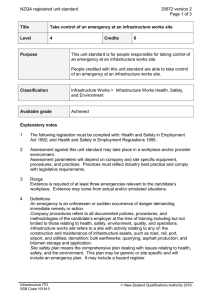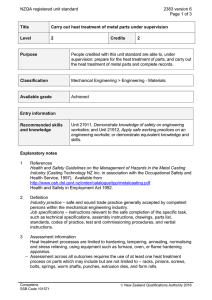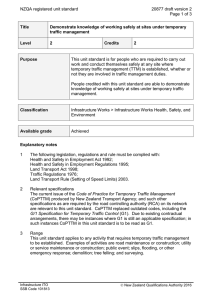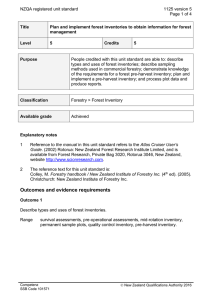NZQA registered unit standard 20584 version 2 Page 1 of 4
advertisement
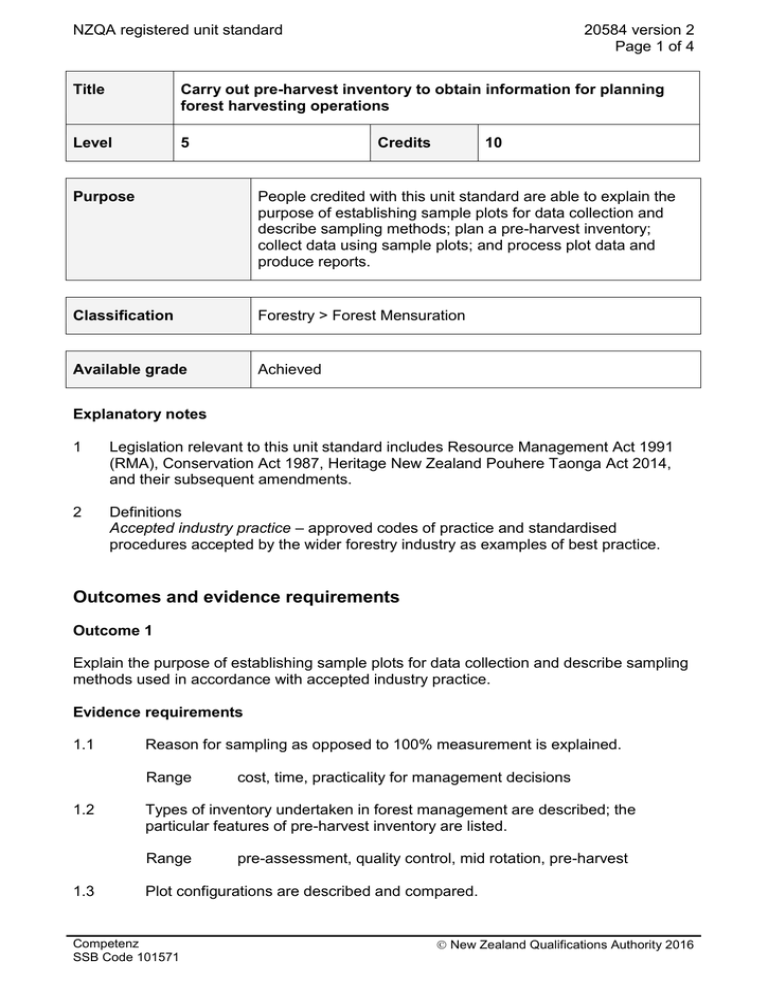
NZQA registered unit standard 20584 version 2 Page 1 of 4 Title Carry out pre-harvest inventory to obtain information for planning forest harvesting operations Level 5 Credits 10 Purpose People credited with this unit standard are able to explain the purpose of establishing sample plots for data collection and describe sampling methods; plan a pre-harvest inventory; collect data using sample plots; and process plot data and produce reports. Classification Forestry > Forest Mensuration Available grade Achieved Explanatory notes 1 Legislation relevant to this unit standard includes Resource Management Act 1991 (RMA), Conservation Act 1987, Heritage New Zealand Pouhere Taonga Act 2014, and their subsequent amendments. 2 Definitions Accepted industry practice – approved codes of practice and standardised procedures accepted by the wider forestry industry as examples of best practice. Outcomes and evidence requirements Outcome 1 Explain the purpose of establishing sample plots for data collection and describe sampling methods used in accordance with accepted industry practice. Evidence requirements 1.1 Reason for sampling as opposed to 100% measurement is explained. Range 1.2 Types of inventory undertaken in forest management are described; the particular features of pre-harvest inventory are listed. Range 1.3 cost, time, practicality for management decisions pre-assessment, quality control, mid rotation, pre-harvest Plot configurations are described and compared. Competenz SSB Code 101571 New Zealand Qualifications Authority 2016 NZQA registered unit standard Range 1.4 variance, mean, range, total, standard deviation, standard error, probable limits of error Types of growth models are explained in relation to pre-harvest inventory. Range 1.8 plot shape, plot size, sampling method, sampling intensity, bias Statistical terminology used to describe the accuracy and precision of estimates is explained. Range 1.7 random, systematic, cluster, double, stratified sampling Sources of inaccuracy and imprecision in inventories are described. Range 1.6 circular, square/diamond, transect, bounded and unbounded, horizontal line, single stem plots Methods of sampling are described. Range 1.5 20584 version 2 Page 2 of 4 stand based, single tree Maps are interpreted prior to fieldwork. Range scale, bearings, scale distances Outcome 2 Plan a pre-harvest inventory and collect data using sample plots. Evidence requirements 2.1 An inventory plan is prepared in accordance with accepted industry practice. Range 2.2 Planning determines the number of plots and their shape, size, location and measurements necessary to achieve inventory purpose. Range 2.3 bounded and unbounded plots, sample size, population/stratum boundaries Plot locations are planned on maps or aerial photographs and located on the ground without bias. Range 2.4 definition of objectives, critical data, level of accuracy and precision, equipment, manpower, maps, plot sheets, assessment techniques, data processing requirements, reporting requirements, quality assurance stand gaps, edge plots, plot demarcation Stem architecture is described in relation to quality assessment in accordance with accepted industry practice. Competenz SSB Code 101571 New Zealand Qualifications Authority 2016 NZQA registered unit standard Range 2.5 annual shoots, branch clusters, internode characteristics, multiple leaders, diameter reductions, broken tops, abnormal taper Stem assessment parameters are derived in relation to log product specifications in accordance with accepted industry practice. Range 2.6 20584 version 2 Page 3 of 4 branch size classes, branch angle, sweep, visual defects, out of round Plot measurements are undertaken to the required standard without bias. Range stem structure, shape, size, branching, defects. Outcome 3 Process plot data and product reports. Evidence requirements 3.1 Function set required for analysis is determined, in accordance with accepted industry practice. Range volume and taper, height/diameter relationship, stem breakage, height and basal area growth, branch size, wood density 3.2 Cutting strategy is determined to achieve log product requirements. 3.3 Data is introduced to the system, in accordance with accepted industry practice. Range 3.4 Reports are produced and interpreted, in accordance with accepted industry practice. Range 3.5 precision statements, per stem and per hectare parameters Re-analysis of inventory is undertaken, in accordance with accepted industry practice. Range 3.6 manual entry, field computer import sensitivity analysis, changing cutting strategies, post stratification Storage and transfer of yield information is described, in accordance with accepted industry practice. Range Competenz SSB Code 101571 Geographical Information System (GIS), spreadsheet, database New Zealand Qualifications Authority 2016 NZQA registered unit standard Planned review date 20584 version 2 Page 4 of 4 31 December 2020 Status information and last date for assessment for superseded versions Process Version Date Last Date for Assessment Registration 1 23 November 2003 31 December 2017 Review 2 10 December 2015 N/A Consent and Moderation Requirements (CMR) reference 0173 This CMR can be accessed at http://www.nzqa.govt.nz/framework/search/index.do. Please note Providers must be granted consent to assess against standards (accredited) by NZQA, before they can report credits from assessment against unit standards or deliver courses of study leading to that assessment. Industry Training Organisations must be granted consent to assess against standards by NZQA before they can register credits from assessment against unit standards. Providers and Industry Training Organisations, which have been granted consent and which are assessing against unit standards must engage with the moderation system that applies to those standards. Requirements for consent to assess and an outline of the moderation system that applies to this standard are outlined in the Consent and Moderation Requirements (CMR). The CMR also includes useful information about special requirements for organisations wishing to develop education and training programmes, such as minimum qualifications for tutors and assessors, and special resource requirements. Comments on this unit standard Please contact Competenz at qualifications@competenz.org.nz if you wish to suggest changes to the content of this unit standard. Competenz SSB Code 101571 New Zealand Qualifications Authority 2016

